Looking for a NOCaaS partner? You just found it.
.png?width=1273&height=450&name=imageonline-co-roundcorner%20(1).png)
Our award-winning outsourced NOC support services provide exactly the level of support you need—when you need it. Focus your attention and resources on revenue-generating projects and leave infrastructure monitoring and management to us. Our NOC can rapidly respond to incidents and events and continue to implement changes as needed, all under a more cost-effective service model.
No matter the size or type of your business, outages are inevitable. Some may have a limited impact. Others may cause severe and potentially catastrophic damage. In any case, every second of downtime can cost you time and money.
A properly developed and well-managed Network Operations Center (NOC) is the bulwark against downtime and its costs. An effective NOC is both reactive in mitigating losses when unavoidable downtime strikes and proactive in improving network, infrastructure, and application performance to keep those events to an absolute minimum.
A poorly organized and run NOC, by contrast, leaves your technology investments—and the business activities that rely on them—constantly exposed and vulnerable.
The “NOC as a service” (or NOCaaS) support model helps enterprises and communications service providers offload the costs and complexities of establishing and maintaining a NOC to better allocate their resources to revenue-generating projects.
Here, we define what NOC as a service means and what companies should consider when deciding how best to pursue and secure the support they need.
What is “NOC as a Service”?
.png?width=1273&height=450&name=imageonline-co-roundcorner%20(4).png)
The term “NOC as a Service” can have a few different meanings, so it’s important to clarify what we’re talking about.
NOC as a Service (Network Operations Center as a Service) is an outsourced model where an organization contracts with a specialized third-party provider to handle the 24/7 monitoring, management, and support of its IT infrastructure and networks.
Here at INOC, we use the term "NOC as a Service" interchangeably with "Outsourced NOC Services." They both typically refer to a customized outsourced operational service that takes on the cost and complexity of setting up and completely running operations or augmenting the client’s NOC, such as performing off-hours services or operationally and technically managing a subset of the infrastructure.
The NOC service provider first conducts an assessment to learn precisely how the service needs to be established and operationalized. Then they work with the client to turn up services. Support is delivered as an ongoing service—likely much more cost-effectively and less stressfully than performing those functions in-house.
This service typically includes:
- 24/7 real-time monitoring of networks, servers, applications, and other IT systems
- Proactive detection and response to issues, outages, and performance degradations
- Incident management, including troubleshooting and resolution or escalation
- Alert handling and notification to relevant stakeholders
- Ticket management and tracking
- Performance reporting and analytics
- Capacity management and planning
The features and benefits of the NOC as a Service model that attracts so many companies to it versus building a NOC in-house include:
- Access to skilled NOC technicians and engineers without the need to hire and train in-house staff
- Scalable support that can adapt to changing business needs
- Utilization of advanced monitoring tools and AIOps (Artificial Intelligence for IT Operations) platforms
- Standardized processes and procedures for consistent service delivery
- A tiered support structure (typically Tier 1, 2, and 3) to efficiently handle issues of varying complexity
- Integration with existing tools and systems used by the client organization
- SLAs to ensure performance and accountability
- Cost-effectiveness due to economies of scale and shared resources
In essence, the NOC as a Service model allows organizations to benefit from enterprise-grade NOC capabilities without the significant investment in infrastructure, tools, and personnel required to build and maintain an in-house NOC. This model is particularly beneficial for businesses that need 24/7 support but cannot justify the expense of a fully staffed internal NOC or for those looking to free up their internal IT resources to focus on more strategic initiatives.
When companies say they’re looking to “stand up a NOC” and are considering doing that themselves or outsourcing that work to a third-party NOC provider, NOC as a Service, as we described it here, is most likely the right fit. Companies typically have a lot of tasks for the NOC to do; the support provider will replicate what an in-house NOC team would otherwise be doing and carry out support.
That’s in contrast to, for instance, turning up service for some number of devices at a specific set price per month. That’s more in line with a traditional managed service—something that’s a great fit for IT integrators or circuit providers looking to add white-labeled support to their products, but not such a great fit for most enterprises and service providers that need a much more involved and customized solution. (Head to our partner page to learn more about enhancing your managed service offering with 24x7 white-labeled NOC support.)
Why do businesses outsource NOC support through the NOC as a Service model?
.png?width=1273&height=450&name=imageonline-co-roundcorner%20(5).png)
There are typically seven key reasons companies partner with us to take advantage of the NOC as a Service model.
Let's break them down quickly.
1. Cost-effectiveness
Establishing and maintaining an in-house NOC requires significant investments in personnel, tools, and infrastructure. For most businesses, these expenses are hard to justify due to the typically low utilization rates of in-house NOC resources. Most companies needing NOC support don't require enough to justify building and staffing an in-house NOC. Outsourcing NOC support allows access to high-quality services at a fraction of the cost — often 50% less than running an in-house operation at INOC.
- Consider that most NOCs need at least ten people to provide reliable 24/7/365 support. Comparing the total in-house human resource costs to a smaller team of outsourced FTEs in a mature NOC environment quickly reveals the cost advantage of strategic outsourcing. For most companies, staffing a NOC is a needlessly high expense compared to outsourcing. An in-house plan might call for 12 full-time employees, while outsourced services can provide the same or better support through economies of scale at a much lower cost.
- Beyond staffing, the cost of acquiring, implementing, and integrating a full suite of NOC tools further tips the scale in favor of outsourcing. Essential NOC functions like monitoring, ticketing, knowledge centralization, and reporting require tools that constitute a massive expenditure, often unjustified by their low utilization in most homegrown NOCs. Newer technologies like machine learning and automation (AIOps) add to the costs and complexity of implementation.
- Many companies find the payroll and overhead costs of building an in-house NOC significantly higher than outsourcing. Outsourced support can cut their total cost of ownership in half. These savings extend beyond obvious expenditures, addressing hidden costs that can become expensive problems if overlooked initially.
2. Access to expertise and operational maturity
Compared to the months or years needed to find NOC specialists, build a team, and develop an operationally mature in-house NOC, outsourcing can condense this process into just a few weeks—often more cost-effectively.
- Finding NOC specialists with the necessary expertise is challenging. Developing an operational framework for the NOC requires highly specialized experience, which is hard to find in the labor market.
- This specialization is crucial to ensure the NOC can effectively handle all operational challenges. Operational blindspots—unknown issues—are common and can have far-reaching consequences for both the NOC and the business.
- If the NOC isn’t thoughtfully designed to address specific challenges, it will likely face stressful and expensive problem-solving in the future.
3. Speed to service (or speed to market)
Building an in-house NOC involves planning, hiring, training, and aligning over the operational plan, which can take a minimum of 16 to 24 weeks. Gaining confident control over the system can take additional months.
For many companies, achieving operational maturity — where the NOC has the necessary data, technical capability, and support to improve continually — can take years.
- Finding and hiring talent is a major hurdle in getting a NOC up and running. The deep operational expertise required to build a sophisticated NOC is hard to find and expensive to acquire, but it is critical at the outset. Identifying the full range of support requirements and resourcing a qualified management professional can considerably delay the project.
- At INOC, we leverage our extensive experience in designing and implementing NOC operations to deliver comprehensive best practices NOC consulting. We help design and build new NOCs and significantly improve existing ones, whether they remain in-house or are managed by us.
4. Scalability and flexibility
Outsourced NOCs offer significant scalability and flexibility. As your business grows, our NOC can seamlessly scale to meet increasing demands without the need for additional in-house investments.
This flexibility allows for quick adaptation to changing business needs, whether it’s expanding services, accommodating new technologies, or adjusting to fluctuating workloads. Our clients maintain optimal performance and reliability without the complexities and costs of scaling an in-house operation.
- At INOC, our shared NOC is staffed with skilled personnel, including tiered groups of engineers, change specialists, and round-the-clock management. Once the systems to be monitored are integrated with our infrastructure, we receive and ticket alerts, emails, and phone calls, triaging them for severity and addressing them as our engineers move through the queue of shared client events.
- Our engineers use INOC tools and alarm-to-action guides based on standardized support methods, customized to fit each client’s business. This approach allows our shared NOC to be highly scalable through platform integrations. Escalations are typically managed internally by shift supervisors and managers, ensuring efficient issue resolution.
5. Reduced burden on your valuable technical resources
Requiring staff to be on-call after hours and on weekends to respond to alerts could seriously affect morale and job efficiency. Burnout and potential indifference due to nuisance alarms and alerts add to the toll.
By outsourcing NOC support, companies redirect their internal IT resources towards more strategic, revenue-generating projects so they can innovate and grow while leaving break/fix to true NOC experts.
- Staffing a 24x7 NOC requires staffing three shifts a day, 365 days a year. Providing a productive, healthy work environment that attracts and retains talent you can rely on isn’t easy. Often, NOCs don’t provide the structure and support commensurate with the demands on the typical NOC engineer. The high turnover further burdens management and HR while leaving the door open to serious risks.
- An effective outsourced NOC partner will shoulder the burden of staffing, so, again, you can focus in-house resources on more important revenue-generating activities. Here at INOC, our staffing strategy is designed to make work both challenging and fulfilling for everyone. Work is manageable, support is given, and everyone has an opportunity to grow.
6. 24/7 monitoring and support coverage
Many businesses grow or evolve to require round-the-clock network monitoring, which can be challenging and expensive to maintain in-house. NOC service providers offer 24/7 support as a standard feature, ensuring constant vigilance over your networks.
7. Improved monitoring and management performance
Professional NOC service providers often deliver improved performance thanks to their specialized focus and advanced tools. They typically offer detailed reporting and analytics, allowing businesses to track and optimize their network performance more effectively.
Here are just a few specific examples from our client book:
- A 30% auto-resolution rate for a leading network OEM, reducing major escalations and streamlining the onboarding of over 800 customers.
- A reduction in NOC support onboarding time from 6 weeks to 1 week for AT&T Business, significantly decreasing site escalations.
- Enhancements in Adtran's NOC service offering, leading to a 26% reduction in time-to-ticket and a 50% reduction in time-to-resolution.
- For Aqua Comms, updated runbooks and a professional services catalog adjustment resulted in a 20% reduction in ticket volume and a 5-minute SLO from alarm detection to ticket creation.
- SHI experienced a 10x decrease in average MTTR, underscoring the platform's ability to alleviate support burdens and improve resolution times.
8. Immediate access to advanced tooling/support platform
NOC service providers invest heavily in advanced monitoring tools, analytics platforms, and robust infrastructure. These resources are often beyond the reach of individual companies due to high costs and complexity.
Here at INOC for example, our clients inherit the capabilities of our Ops 3.0 Platform — our operating system for delivering NOC service. Its design enables us to ingest alarm feeds from various sources, auto-correlate those events into a single ticket, and present that ticket through a single pane of glass for efficient Incident, Problem, and Capacity Management.
In short, the Ops 3.0 platform enables our team to increase its accuracy and speed while reducing delays in human involvement. It frees NOC engineers to spend less time in the runbook and more time on strategic client projects.
More on that below.
The INOC Ops 3.0 Platform
Ops 3.0 is the third major iteration of INOC's platform, serving as a comprehensive operating system for technology, operations, and service delivery. It enhances NOC service delivery by automating the ingestion, correlation, and ticketing of alarm feeds, increasing accuracy and speed while minimizing human delays.
- The platform employs AIOps (AI for ITOps) to automate key tasks, prioritize incidents based on their business impact, and automatically generate incident tickets with enriched data for efficient resolution.
- Key features include automated alarm correlation, incident automation, self-service client portal, auto-resolution of short-duration incidents, and a secure multi-tenant architecture. These capabilities ensure rapid incident response, cost savings, and high availability.
- Ops 3.0 integrates seamlessly with various NMS platforms and ITSM tools, leveraging a robust CMDB and automated workflows to expedite action on incidents. This integration simplifies the incident management process, making it faster and more efficient.
- INOC's structured NOC approach, featuring an Advanced Incident Management team, ensures effective incident resolution and resource allocation. The onboarding process is tailored to align the platform with clients' unique operational needs, ensuring a seamless integration and customized service experience.
Below is a high-level schematic of the platform and how it connects to — and integrates with — a client's infrastructure and existing NMS, ITSM, and communications tooling.

Open larger image in new tab »
The workflow generally moves from the left to the right of the diagram as monitoring tools output alarm and event information from a client NMS or ours into our platform, where a number of tools process and correlate that data, generate incidents and tickets enriched with critical information from our CMDB, and triage and work them through a combination of machine learning and human engineering resources. ITSM platforms are integrated to bring activities back into the client's support environment and the system is integrated with client communications.
Our VP of Technology, Jim Martin, explains:
Here's a more detailed breakdown of the platform:
- INOC NMS or Integrated Manager of Managers: Our NMS can receive event data and poll you or your customers' infrastructure elements—network, cloud, and applications—using a variety of mechanisms and protocols. Whether you need direct monitoring or want us to integrate current monitoring tools, we seamlessly connect the INOC Ops 3.0 Platform to your infrastructure or your tools so alarms flow freely to us.
- Correlation, Machine Learning & Automation (AIOps): We use advanced machine learning tools to quickly identify network, infrastructure, and application issues. Our AIOps engine automates low-risk tasks and extracts valuable insights from vast amounts of data. Our platform streamlines alarm correlation, enrichment, and automatic ticket creation. It automatically identifies and attaches CIs from our CMDB, giving NOC engineers clear direction for investigation before any human intervention. It also supplies relevant knowledge articles and runbooks, facilitating fast and accurate diagnosis and action plan development.
- TicketViewer: TicketViewer serves as a queue management tool for our NOC engineers, helping them determine what's in the queue and which corresponding SLAs are in place. The tool allows NOC management to allocate resources effectively and ensures proper coverage for critical incidents by displaying tickets in color-coded stages based on urgency. TicketViewer plays a crucial role in managing SLAs and prioritizing incidents.
- ITSM/Ticketing: Our platform has an ITSM component that boosts automation capabilities by linking CIs and records from the CMDB to incident tickets generated by AIOps. This automated process facilitates the initial impact assessment and offers NOC engineers a probable set of issues and affected service areas even before they start working on the ticket. The platform also automatically attaches knowledge articles and runbooks, which help the NOC engineer access reference material promptly for diagnosis and action plans.
- KPIs & Reporting: Warehoused data is fed into your client portal, which provides clear reporting overviews into KPIs through dashboards, as well as detailed information on NOC support activity, real-time network status, and performance. Standard and custom reports based on event, incident, and performance data are available from the portal.
- Runbooks, Knowledgebase, and CMDB: Our runbooks outline the critical inputs that drive NOC service and provide step-by-step procedures for handling them, whether a phone call, email, or event-based notification. Our runbooks also describe the outcomes of these actions, both successful and unsuccessful, with clear escalation paths to other levels of support. These paths can direct action internally or to external third parties. By focusing on the top alarms and creating runbooks and knowledge articles around resolving these, our platform achieves high Tier 1 incident resolution rates.
- Integrations (ITSM and Communications): In addition to integrating with your existing monitoring infrastructure, our platform also integrates with your existing ITSM tools, improving incident resolution efficiency by identifying and attaching relevant configuration items and knowledge articles. We integrate ticketing platforms bidirectionally so incidents can be passed from our platform to yours, where they can be actioned if needed. This creates a seamless, integrated support experience, allowing you to interact with tickets in your platform while receiving critical updates from ours. We also integrate with communication tools to inform you of high-priority tickets and other critical updates.
What services or functions are included in a comprehensive NOC as a Service offering?
.png?width=1273&height=450&name=imageonline-co-roundcorner%20(2).png)
Once companies see the comparative upside to outsourcing their NOC support, the next question is, “What exactly will we get?”
That answer will vary from one service provider to the next, which is why it’s critical to ensure a provider’s service catalog is well-defined and covers exactly what you need along with value-added services.
Here at INOC, our service catalog covers a wide range of operational support functions for proactively monitoring, detecting, and measuring service availability and performance across the infrastructure and its support operations—24x7 or whenever you need us.
Here's a high-level breakdown of our service catalog:
- Event Monitoring and Management: We monitor, detect, and process events and faults related to client networks, IT infrastructures, and services, such as status changes or usage, to determine the appropriate action, often resulting in an incident being logged for fault management.
- Incident Management: We detect and resolve incidents in order to restore services as quickly as possible and minimize downtime of our clients’ proactively monitored infrastructure and services. Notification, Tier 1, 2, and 3 services are available.
- Problem Management: For those receiving our Tier 3 Incident Management services, Standard Problem Management includes performing activities needed to diagnose the root cause of incidents and submitting change requests to resolve those problems. Predictive Problem Management aims to avoid incidents proactively. This service also maintains information about problems and workarounds for use by Incident Management.
- Capacity Management: We record and manage the performance, utilization, and capacity of our clients’ infrastructure components to ensure client service-level targets are being met.
- On-Demand NOC Support: We provide NOC support for our non—24x7 clients for backup, overflow, disaster recovery, etc.
- Product Support: We provide white-labeled technical support to clients of system integrators, OEMs, and independent software vendors. Notification, Tier 1, 2, and 3 services are available.
- Help Desk Support: We record and manage service requests — for information, advice, standard troubleshooting support, or access to a service — for our clients' end users and end customers.
- Call Center Support: We record and route calls from our clients’ end users and end customers.
- Service Transition Planning and Support: We work together with our clients to define the specific steps for the initial setup of support, including per-customer onboarding, if applicable.
- New Service Onboarding: We onboard client and customer infrastructure with client-supplied information and assistance. Get in touch with us to see all the services included in standard turn-up support, including CMDB setup, connectivity, ticket system, alarm monitoring setup, call and email setup, NOC runbooks, and much more.
- Change Management: We record and manage changes to infrastructure, services, and monitoring. After New Service Onboarding is complete, we make subsequent changes to our support to reflect changes in our clients’ or their customers’ infrastructure and support environments. These changes include scheduled maintenance support as well as Requests for Change, including move, add, change, and delete requests.
- Service Asset and Configuration Management: SACM defines the service and infrastructure components required to deliver services to our clients and maintains accurate configuration records. Configuration records also include service and asset relationship information. This support process allows for better Change Management, Incident Management, and Problem Management and ensures adherence to standards, legal requirements, and regulatory obligations.
- Service Reporting and Service Analysis: Service Reporting provides reports about INOC support. Service Analysis aligns the services with changing client business needs by identifying and implementing improvements to the services we provide. The objective of this process is to improve effectiveness and achieve these objectives in more economical ways. Service Analysis measures and monitors process compliance, quality, performance, and the business value of a given process.
- Complementary Support Services: Complementary support services include Platform Integration Services, Client Runbook Development, Client Infrastructure Management Setup, Custom Functionality, and Provisioning.
Support models may look different from one service provider to another. Here at INOC, our NOC support clients receive service through one of four models depending on their needs or desired service arrangement:
- The Shared NOC Support model utilizes our team of over 100 staff to provide NOC support for hundreds of clients. This model offers clients a cost-effective alternative to hiring dedicated resources when low utilization and other factors can’t justify the cost of an in-house or dedicated team. Because the same team supports multiple clients, clients using this model must connect to our support platform.
- In the Hybrid NOC Support model, our shared NOC team handles Tier 1 support activities, but we escalate to specific Tier 2 and 3 specialists that are partially or fully assigned to a specific partner or client for a given period of time—whenever those resources are needed. These advanced staff can use client-specific tools if needed or desired.
- In the Dedicated NOC Support model, a team of NOC engineers “lives in” one partner’s or client’s tools all the time—solely supporting their environment within their environment. This model is most similar to a traditional IT staff augmentation model where staff are managed by our team but work exclusively with another organization’s tools and processes.
- In the Designated NOC Support model, perhaps two or three partners or clients are supported by a single, dedicated team. This model is ideal for organizations that require or prefer dedicated resources but don’t have the activity volume to justify having a fully dedicated team all to themselves. This team can operate with the client’s tools, INOC’s tools, or a combination.
Read also: Shared vs. Dedicated NOC Support: A Quick-Guide
What problems does NOC as a Service solve?

An underperforming NOC can suffer from a number of challenges. Sometimes, it’s a technical problem, such as a monitoring tool that hasn’t evolved or an NOC that’s under-operationalized and dangerously vulnerable as a result.
In the former case, an expert outsourced service provider can help you understand exactly which tools are optimal given the factors at hand or how existing tools can be updated, condensed, or reconfigured to meet the business’s evolving needs.
In the latter case, a service provider will immerse themselves in your business to understand how best to operationalize the support function. An experienced NOC service provider will collectively have an extensive breadth of best practices and a clear process for capturing service gaps and readily resolving them—important capabilities that are tough to pull off in-house.
Below, we’ve identified five of the eleven challenges we see and solve most often with effective outsourced support. For more information on these and other common challenges, grab our free white paper, Top 11 Challenges to Running a Successful NOC.
1. Lack of tiered organization and workflow
The absence of a well-structured, tiered organization in a NOC leads to a chaotic environment where all issues, regardless of complexity or urgency, are treated similarly. We see this result in inefficient use of skilled resources, with high-level engineers potentially spending time on simple tasks that could be handled by less experienced staff.
Critical issues may face delayed resolution as they get lost in the mix, and the lack of clear workflows leads to inconsistent problem handling. The "wall of red" effect, where staff are faced with a constant barrage of alerts, can lead to alert fatigue and missed critical issues. This challenge also hampers scalability and effective knowledge transfer within the organization.
Without clear tiers and defined workflows, it becomes exceedingly difficult to:
- Prioritize issues effectively
- Create structured training and career progression paths for staff
- Deliver consistent customer experience
- Scale operations as the volume of issues increases
NOCaaS Solution
The right NOCaaS provider can implement a highly refined tiered structure that optimizes operations.
- Tier 1 handles basic monitoring, support requests, and incident management, typically resolving 65-75% of issues. This tier acts as the first line of defense, handling routine tasks efficiently.
- Tiers 2 and 3 are staffed with more experienced personnel who focus on complex problems and specialized technologies.
The service provider organizes workflow into sophisticated queues based on SLAs, technology types, and required skill levels.
Based on data collected across our NOCs, we found this structure can enable a NOC to resolve 65% to 75% of incidents at the Tier 1 level while reserving Tier 2 and 3 staff for more advanced issues.
Classifying NOC activities is often the first step in implementing a tiered structure. Use the following model for developing your own classification system:
- Monitoring events from technology infrastructure and facilities — e.g., Layer 1, 2, and 3 networks, circuits and servers (physical, virtual, and cloud), applications, databases, and power and building systems
- Managing support requests from customers and technical staff in the form of phone calls, emails, and tickets
- Managing incidents resulting from events and support requests
- Managing configurations and changes, provisioning equipment, services, and circuits, and maintaining documentation
- Reviewing periodic service reports
Figure 1 below illustrates a well-organized tiered NOC support structure in action. Here, the Tier 1 team uses monitoring tools and interacts with end-user help desks, as well as Tier 2 and 3 engineers and third parties. Information flows between the various entities within a well-defined process framework.
%20rev2-1.png?width=707&height=387&name=INOC.COM%20%20NOC%20Best%20Practices_%2010%20Ways%20to%20Improve%20Your%20Operation%20in%202020%20(1)%20rev2-1.png)
This tiered approach allows for optimal resource allocation, faster resolution times, and a reduction in routine tasks for high-level engineers. A great service partner continuously refines this structure based on performance data and emerging technologies, keeping the NOC agile and efficient.
2. Absence of meaningful operational metrics
One of the top frustrations we hear from the NOC and support teams we talk to is an inability to make data-driven decision-making and manage performance across their operation. Without comprehensive, relevant metrics, management cannot get a clear picture of NOC performance, making it challenging to identify areas for improvement or set realistic goals. They're flying blind.
This absence of data and reporting affects various aspects of NOC management, from resource allocation to performance evaluation. It becomes difficult — and sometimes near impossible — to demonstrate the NOC's value to upper management or clients without concrete performance data. The lack of trending data also hinders proactive management and effective capacity planning.
We typically see a few problems emerge from this:
- An inability to objectively assess staff performance, leading to morale issues and turnover
- Difficulty in identifying systemic issues and patterns
- Challenges in continuous improvement due to the inability to measure the impact of process changes
- Risk of SLA violations without real-time performance tracking
NOCaaS Solution
A NOC as a Service provider implements a comprehensive suite of KPIs and operational metrics, leveraging their extensive experience across multiple clients. These metrics go beyond basic measures to provide deep insights into NOC performance.
Here at INOC, we immediately give our clients a suite of reporting data, including (but certainly not limited to):
- "Alarms Received" and "Alarms Displayed" to measure event volume and filter effectiveness
- "Average Time to Ticket Events" and "Average Time to Ticket Email" to gauge response speed
- "Time to Impact Assessment" to measure problem identification efficiency
- "Mean Time to Restore" and "Mean Time to Close" for resolution efficiency
Crucially, we also implement advanced utilization metrics that show exactly how NOC resources are being used. These include:
- Labor content for each edit of a ticket
- Number of edits processed/performed per hour
- A heatmap of edits by the time of day and day of week
We use sophisticated analytics tools to process this data, generating actionable insights. We provide regular, detailed reports to clients, often through real-time dashboards, allowing for transparent oversight of NOC performance. This data-driven approach enables continuous improvement, helps in capacity planning, and ensures the NOC consistently meets or exceeds SLAs.
For example, by measuring the labor content for each ticket edit, NOCs can accurately determine staffing needs and workload distribution. The heatmap of edits helps in making precise staffing decisions for different times and days. These metrics, when used together, provide a holistic view of NOC utilization, enabling teams to optimize their operations for peak performance and efficiency.
Read our other guide for much more information on NOC metrics.
3. Challenges in staff hiring, training, and retention
The rapidly evolving technology landscape creates a significant skills gap, making it difficult to find candidates with the right mix of skills for NOC operations.
Our own Austin Kelley and Brandon Atkins explain:
High turnover is common due to the high-stress nature of NOC work, often involving night shifts, which can lead to burnout. The complexity of systems and processes results in lengthy onboarding periods, with new hires taking months to become fully productive.
Continuous training needs, driven by constant technological changes, can be time-consuming and expensive. Without clear career paths, talented staff may leave for better opportunities elsewhere.
We see this lead to a few specific problems:
- Knowledge retention challenges due to high turnover
- Inconsistent performance stemming from variations in staff skills and experience
- Difficulty in balancing the need for both generalists and specialists in the NOC
The 24/7 nature of NOC operations requires careful scheduling and can lead to work-life balance issues for staff, further complicating retention efforts. Competing with other IT sectors for skilled professionals drives up hiring costs, adding financial pressure to the already challenging task of maintaining a skilled and stable workforce.
NOCaaS Solution
A NOC partner shoulders the burden of staffing — building and maintaining a skilled workforce so you don't have to. At INOC, we implement a comprehensive staffing strategy that begins with a skills-based NOC structure, featuring clear career progression paths from Tier 1 through to specialized roles in Tier 3 and beyond.
Our hiring process is rigorous, leveraging industry connections and advanced screening techniques to identify top talent. Once hired, new staff undergo an intensive training program, typically lasting 4-6 months. This includes classroom training on technologies and processes, simulated incident response scenarios, and carefully supervised on-the-job training.
Ongoing training is a cornerstone of the service — and one we know most clients aren't interested in taking on internally. Our engineers regularly receive updates on new technologies, emerging threats, and evolving best practices. We also offer certification programs and partnerships with technology vendors for advanced training. This approach ensures a stable, highly skilled workforce that can handle any challenge while providing consistent, high-quality service.
4. No standardized process framework
The lack of a standardized process framework leads to inconsistent service delivery, as similar issues may be handled differently by different staff members. This inconsistency not only affects service quality but also makes it challenging to measure performance, implement effective automation, and manage knowledge within the organization.
Without standard processes, staff may waste time deciding how to approach each issue rather than following established procedures, leading to inefficiencies and longer resolution times.
Key challenges arising from this issue include:
- Difficulty in training new staff effectively
- Poor scalability as the NOC grows
- Increased compliance risks in regulated industries
- Ineffective problem and change management
The absence of standardized processes also hampers efforts to implement and manage changes effectively, as there's no consistent baseline from which to work. Resource allocation becomes more challenging without clear processes to estimate resource needs for different types of issues. Ultimately, this lack of standardization can lead to unpredictable experiences for customers, potentially resulting in dissatisfaction and loss of business.
NOCaaS Solution
A NOC service partner should implement robust, standardized process frameworks, often based on ITIL (IT Infrastructure Library) but customized to meet the specific needs of NOC operations. At INOC, we start by implementing critical processes like incident management, problem management, and service desk operations, then gradually expand to cover areas like change management, knowledge management, and service continuity.
These frameworks are deeply ingrained in every aspect of NOC operations. For incident management, for example, we implement a standardized process that includes initial triage, categorization, prioritization, investigation, resolution, and closure, with clear guidelines for escalation and communication at each stage.
We also invest heavily in training to ensure all staff members understand and consistently apply these processes. We use advanced workflow management tools that guide staff through each process, ensuring adherence to best practices.
Regular audits and continuous improvement initiatives keep these processes optimized. We leverage insights gained from managing multiple NOCs to refine these processes continuously, implementing industry best practices and innovative approaches that a single in-house NOC might not have exposure to.
5. A lack of AI integration and automation
The lack of a standardized process framework leads to inconsistent service delivery, as similar issues may be handled differently by different staff members. This inconsistency not only affects service quality but also makes it challenging to measure performance, implement effective automation, and manage knowledge within the organization.
Without standard processes, staff may waste time deciding how to approach each issue rather than following established procedures, leading to inefficiencies and longer resolution times.
Key challenges arising from this issue include:
- Difficulty in training new staff effectively
- Poor scalability as the NOC grows
- Increased compliance risks in regulated industries
- Ineffective problem and change management
The absence of standardized processes also hurts efforts to implement and manage changes effectively, as there's no consistent baseline from which to work. Resource allocation becomes more challenging without clear processes to estimate resource needs for different types of issues.
Ultimately, this lack of standardization can lead to unpredictable experiences for customers, potentially resulting in dissatisfaction and loss of business.
NOCaaS Solution
INOC is at the forefront of implementing AI and machine learning in NOC operations; we're positioned to make investments most companies simply couldn't justify in-house.
Here's a high-level breakdown of some of our top-line capabilities that our clients inherit:
- Automated Alarm Correlation: We use machine learning to significantly reduce the time from initial alarm to incident ticket creation. This ensures that tickets are created for every event deserving of one, and nothing is missed. Alarm experts continually monitor and fine-tune the platform's machine learning, improving speed and accuracy in identifying issues as more data is gathered.
- Incident Automation: The AIOps engine ingests alarms, enriches and correlates them with similar alarms to create a single incident ticket. Automated workflows then assign or attach impacted Configuration Items (CIs) and differentiate the affected services or CIs from the likely cause of an incident. The system also attaches relevant knowledge articles for incident resolution. This level of incident automation is available from day one of service, with further automation of repeatable tasks developed over time.
- Auto-Resolution of Short-Duration Incidents: To reduce non-productive work for NOC engineers, the platform automatically resolves tickets with alarms that clear within a few minutes. This provides faster updates to clients and allows the NOC to focus on critical ongoing issues.
- AIOps Core Functionality: The AIOps engine automates low-risk tasks and extracts actionable insights from vast amounts of data gathered across clients' supported environments. It correlates alarms from multiple sources, performs deep inspection of those alarms, and enriches them with additional metadata from the CMDB to expedite informed action.
- Integration with Existing Systems: Clients can integrate their existing infrastructure monitoring systems with the AIOps toolset, maximizing their current investments while benefiting from advanced automation.
- Automated CI Attachment and Knowledge Base Integration: After ticket generation, the platform automatically identifies and attaches relevant CIs from the CMDB and supplies appropriate knowledge articles and runbooks, facilitating fast, accurate diagnosis and action plan development.
Again, these advanced solutions offer a level of operational excellence, efficiency, and technological sophistication that would be challenging and costly for most organizations to achieve in-house.
By leveraging the scale of data and resources available to them, we deliver faster incident resolution, more proactive issue prevention, and free up human engineers to focus on complex, high-value tasks.
📄 Download our free white paper, Top 11 Challenges to Running a Successful NOC — and How to Overcome Them, for a deeper dive into these challenges and others, including:
- The lack of a business continuity plan for the NOC
- Ineffective customer experience management programs
- Poor platform integrations and data consolidation
- Poor documentation
- A lack of scalability
- Budget overruns
Key considerations when deciding to outsource NOC support
.png?width=1273&height=450&name=imageonline-co-roundcorner%20(3).png)
Although some may assume an in-house NOC affords greater control and is therefore preferred, the right outsourced NOC operation can offer a suite of capabilities and efficiency advantages that dramatically tip the scale in terms of cost and value.
The control and assurance once afforded by keeping the NOC in-house have largely been upstaged by outsourced service providers that have bridged those gaps and developed platform capabilities that simply wouldn’t be viable in-house investments due to low utilization.
Consider the following points when deciding if outsourcing NOC support is optimal for your organization.
The basic math of costs
In most organizations, staffing a NOC is often a needlessly high expenditure compared to outsourcing. Given the payroll and overhead costs of building a NOC in-house, electing for outsourced support can cut your total cost of ownership in half.
A plan that doesn’t consider this opportunity might, for example, call for a staff of 12 full-time employees, when in fact, the same or likely better support could be provided through an outsourced service solution that takes full advantage of an economy of scale to provide far better service at a far lower cost.
In addition to staffing costs, the cost of acquiring, implementing, and integrating a full suite of NOC tools only further tips the scale in favor of outsourcing much of the time.
The impact of operational maturity, access to expertise, and time to value
Perhaps the most apparent difference between homegrown and outsourced NOCs are the capabilities that come with an already-mature operation and access to niche NOC expertise.
Between planning a NOC build, hiring a team, training that team, and aligning over the operational plan, in-house NOCs can expect 16 to 24 weeks minimum before all the parts are even in place. It can then take months or years to gain confident control over the system and bring it into a state of real operational maturity.
Turning up support with an outsourced NOC condenses all that time and effort into a number of weeks instead of years—often far more cost-effectively.
4 steps to outsourced NOC support with INOC
New clients often worry about the process of outsourcing their NOC support through the NOC as a service model. It’s the kind of project teams don't do every day, and depends on asking the right questions and gathering a full set of requirements from the start. Here at INOC, we make onboarding easy with a proven turnup process guided by experts each step of the way.
The graphic below illustrates our 4-step process (which is really a cycle) for turning up, delivering, and continually improving outsourced NOC service. We unpacked each step with a summary below it.
Read our other post for a detailed breakdown of the onboarding process: Onboarding Outsourced NOC Support: 9 Steps to Success
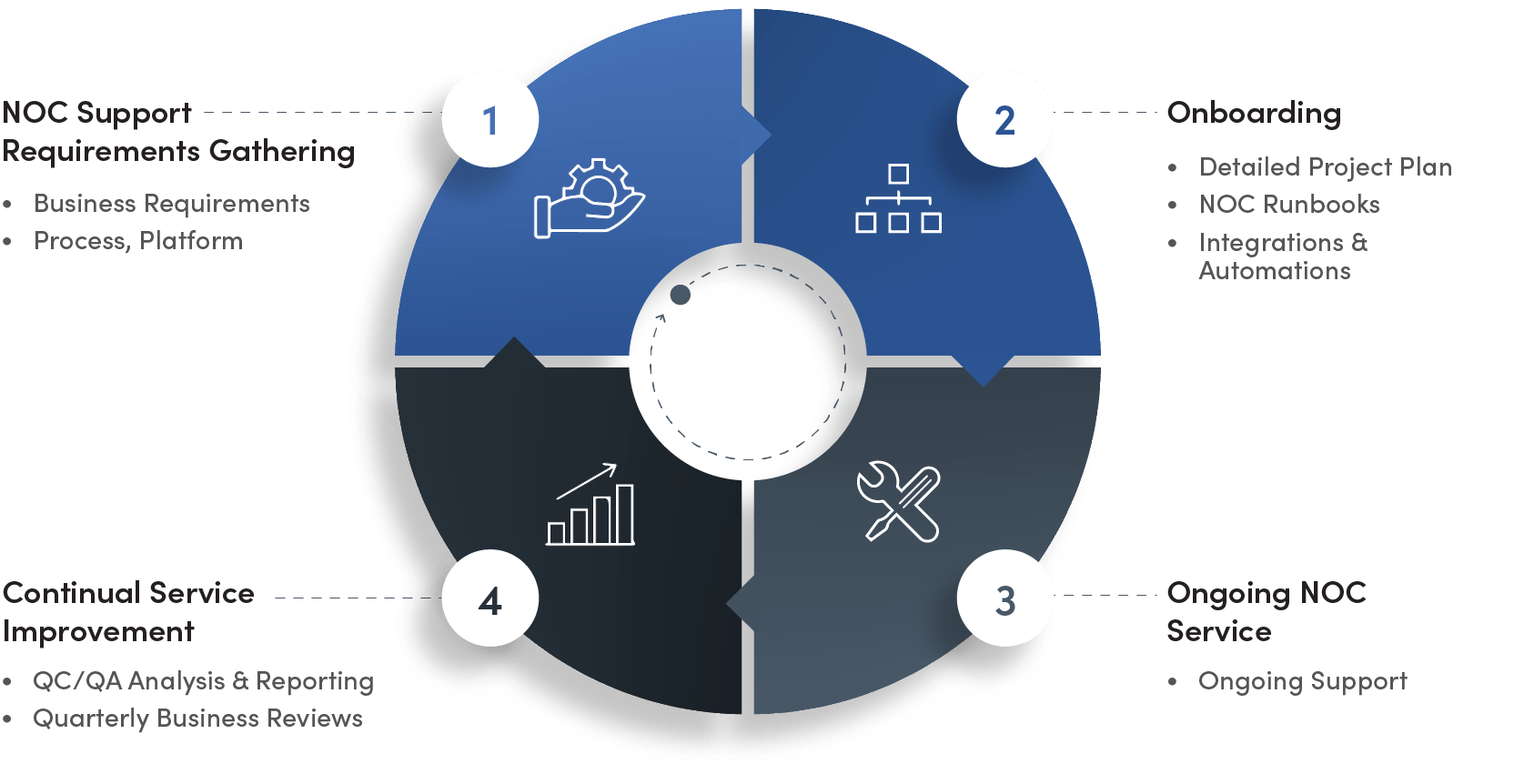
- NOC Support Requirements Gathering: We work closely with you to understand your business needs and what’s driving you towards an outsourced NOC solution. Then we'll drill deeper to understand which specific components of service will be handled by each team. Whether you’re looking for a completely outsourced NOC solution or need supplemental support to fill gaps or scale service, we help you assemble the perfect service package.
- Onboarding: We assign a certified project manager and engagement lead to each onboarding project, who will carefully guide you through the onboarding process each step of the way
- Ongoing NOC Service: Once you’re up and running, we’ll help you understand the nuances of NOC operations and how we cover a vast number of technologies and manage change as we deliver award-winning service.
- Continual Service Improvement: IT environments are anything but static. That’s why we routinely work with you to identify your changing business needs and do everything we can to ensure satisfaction with all of our services. Read our guide to CSI in the NOC here.
Learn more about NOC Turnup & Assessment with INOC.
Summary, Final Thoughts, and Next Steps
For most companies, the cost and complexity of building and managing a NOC is a diversion from focusing its attention where it's needed most: innovating and growing the business.
Without an effective NOC, persistent support issues lead to expensive project delays, endless stress, and serious vulnerabilities that threaten your business.
Through the NOC as a service model, an outsourced support provider helps you take control of your infrastructure through a suite of NOC solutions designed to meet the specific needs of your technology environment and operational workflow—all while enabling you to focus internal resources on the projects that move the business forward.
Want to learn more about our approach to outsourced NOC support? Contact us to see how we can help you improve your IT service strategy and NOC support, schedule a free NOC consultation with our Solutions Engineers, or download our free white paper below.
Frequently Asked Questions
NOC as a Service refers to the outsourcing of Network Operations Center (NOC) functions to a third-party provider who handles the setup, management, and operationalization of your NOC. This can include everything from event monitoring and incident management to advanced support levels, allowing businesses to focus on core functions without the complexity of running an in-house NOC.
Businesses often outsource NOC support to alleviate the high costs and complexities of managing a NOC in-house. Outsourcing allows access to specialized expertise, reduces operational costs, and frees up internal resources to focus on revenue-generating activities. This setup ensures that networks, infrastructure, and applications are managed effectively without the burden of maintaining a full-time, in-house NOC team.
INOC's NOCaaS includes a range of services such as:
- Event Monitoring and Management
- Incident and Problem Management
- Notification Support
- Tier 1 and Advanced Tier 2 & 3 Support
- Capacity and Change Management
- Service Transition and Planning
- On-Demand NOC Support
- Service Reporting and Analysis
These services ensure comprehensive management of your IT infrastructure.
Outsourcing NOC support addresses several challenges including over-utilization of IT staff, high operational costs, lack of up-to-date knowledge and tools, and the operational vulnerability of under-performing NOCs. An outsourced NOC helps streamline operations, improve response times, and ensure continuous monitoring and management of IT systems.
Choosing INOC for NOC support provides businesses with a cost-effective, efficient, and scalable solution to manage their IT infrastructure. Benefits include access to expert staff around the clock, reduction in operational costs, improved performance metrics, and the ability to focus on strategic business initiatives rather than day-to-day NOC operations.
INOC ensures a smooth transition through a structured four-step process that includes requirements gathering, onboarding, ongoing service management, and continual service improvement. This process is supported by certified project managers and engagement leads who guide businesses every step of the way, from initial assessment to full operationalization.
When considering outsourced NOC support, businesses should evaluate the cost implications versus maintaining an in-house team, the expertise and maturity of the service provider, and the potential to improve operational efficiencies. It's also important to consider the specific needs of the business and whether the provider can offer a customized service that aligns with these requirements.
Businesses interested in INOC's NOCaaS can begin by contacting INOC to schedule a free consultation with their Solutions Engineers. This initial consultation will help assess specific needs and explore how INOC's outsourced NOC services can improve their IT service strategy and operational efficiencies.
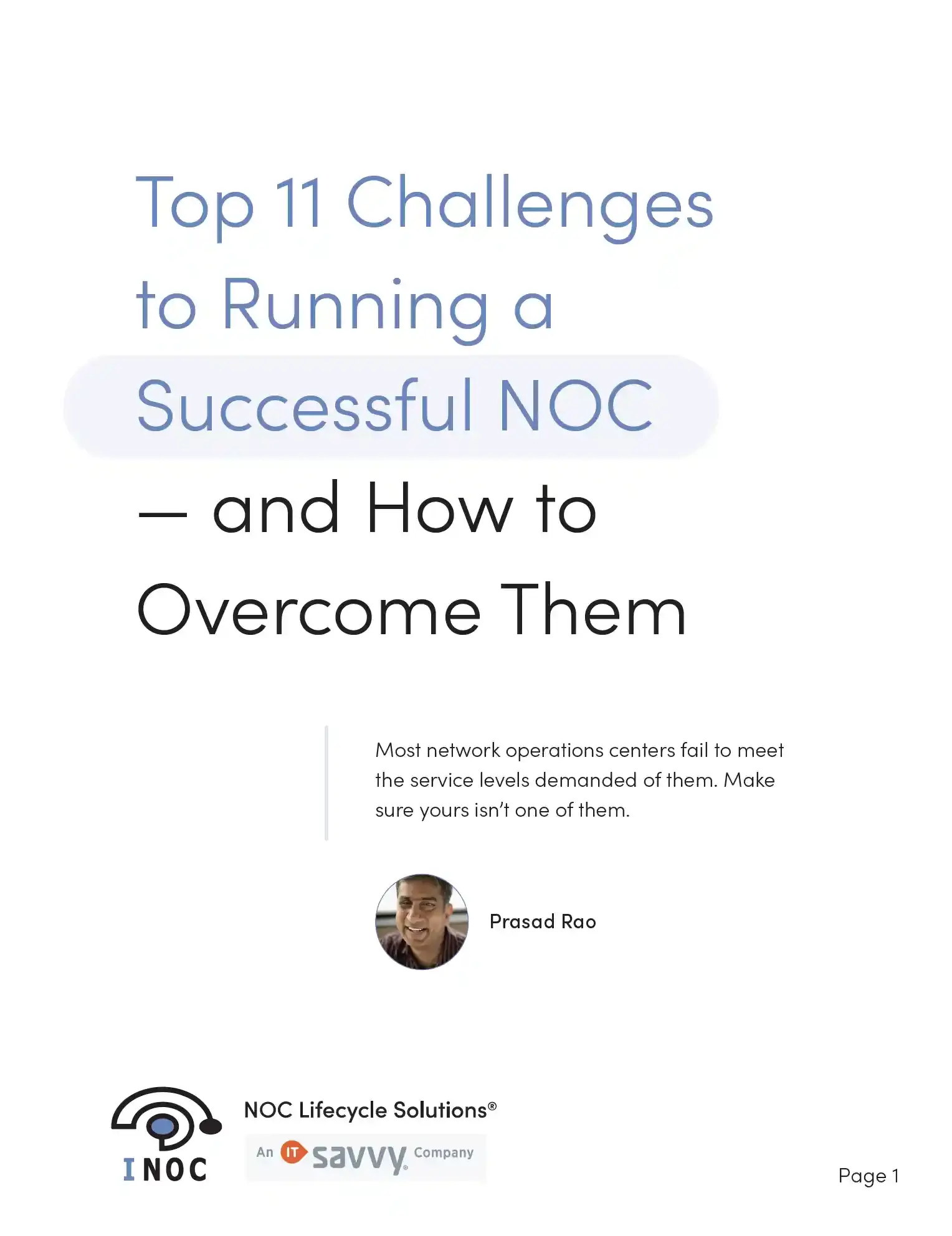
Free white paper Top 11 Challenges to Running a Successful NOC — and How to Solve Them
Download our free white paper and learn how to overcome the top challenges in running a successful NOC.







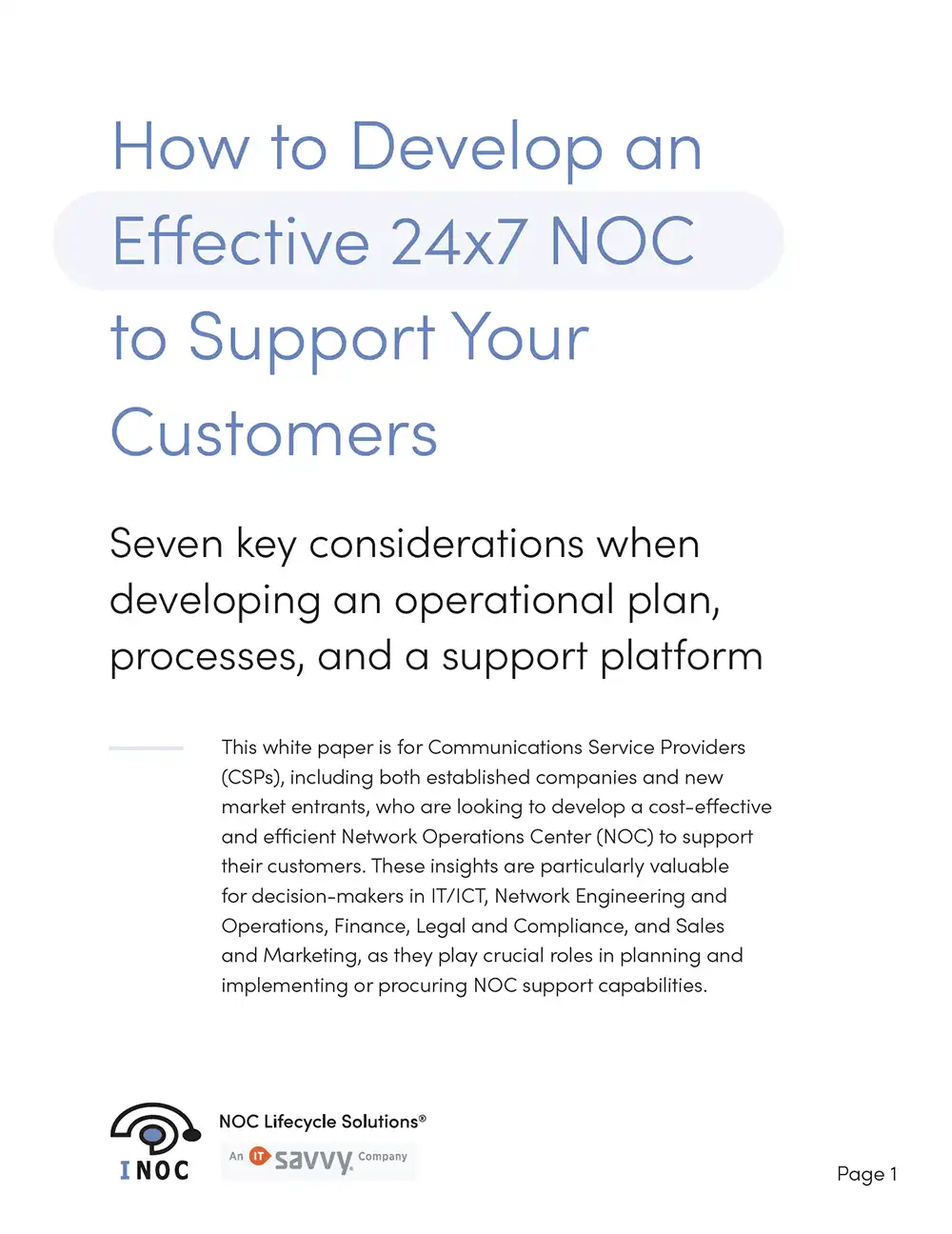

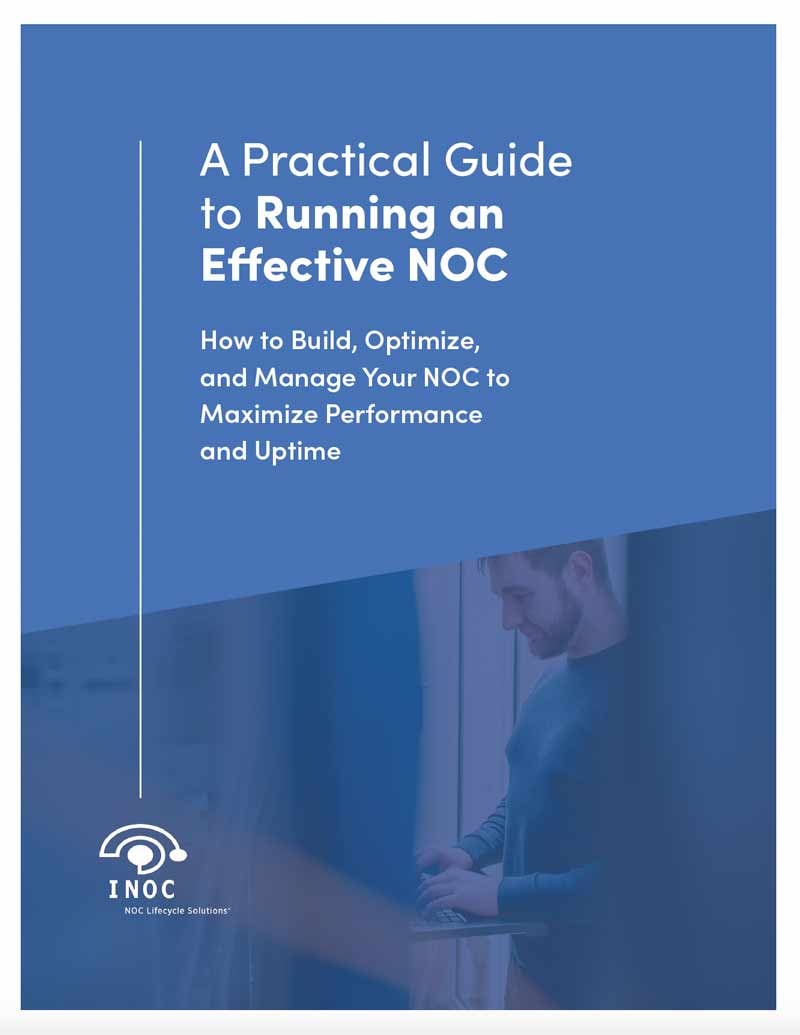
-images-0.jpg?height=2000&name=ino-WP-NOCPerformanceMetrics-01%20(1)-images-0.jpg)

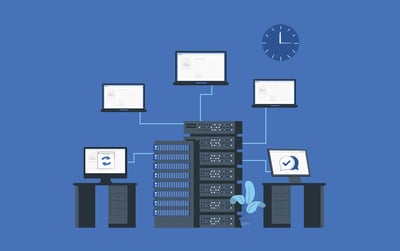

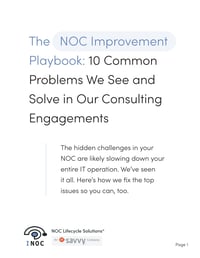

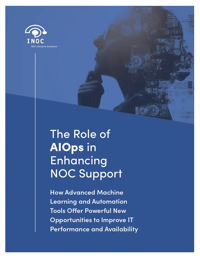

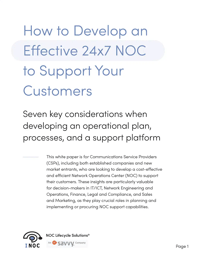
-images-0.jpg?width=200&height=259&name=ino-WP-NOCPerformanceMetrics-01%20(1)-images-0.jpg)